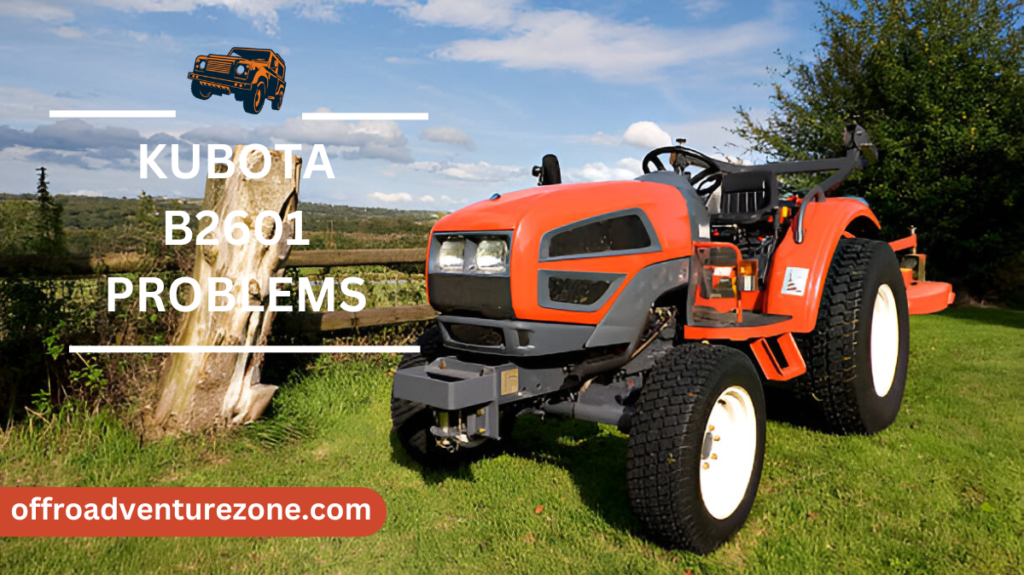The Kubota B2601 is a small but strong tractor that many farmers and gardeners use. It’s like a helper on the farm, doing lots of jobs to make work easier. This tractor can dig, lift, and pull things. It’s important to know how to take care of it and fix any problems that might come up.

Contents
Why Taking Care of Your Tractor is Important
Taking care of your tractor is like taking care of your bike or your pet. If you do it regularly, your tractor will work better and last longer. This means changing the oil, checking the parts, and keeping it clean. When you take good care of your tractor, you won’t have to fix big problems as often, and you’ll save money in the long run.
Common Problems You Might See with Your Kubota B2601
When the Engine Won’t Start
Sometimes, your tractor might not start when you turn the key. This can happen for a few reasons. The fuel might be old or there might not be enough.
The battery could be weak or not connected right. In cold weather, the engine might need extra help to start. If your tractor won’t start, first check if there’s enough fuel and if the battery is working.
When the Hydraulics are Slow
Hydraulics are what make the tractor’s arms move up and down. If these arms move slowly or not at all, there might be a problem with the hydraulic system.
This could be because there isn’t enough hydraulic fluid, or the fluid is dirty. Checking the fluid levels and keeping them clean can help prevent this problem.
Trouble Changing Gears
Changing gears on your tractor should be smooth and easy. If it’s hard to change gears, there might be a problem with the transmission. This could be because the transmission fluid is low or old. It could also be because parts inside the transmission are worn out. Regular check-ups can help catch these problems early.
When the Engine Gets Too Hot
An engine that gets too hot can be a big problem. This can happen if there isn’t enough coolant, or if the fan that keeps the engine cool isn’t working right. Keeping the coolant at the right level and making sure the cooling system is clean can help prevent overheating.
When Electrical Things Stop Working
Electrical problems can cause lights, gauges, or other parts to stop working. This might be because of a dead battery, a broken fuse, or wires that have come loose. Checking connections and keeping the battery charged can help avoid these issues.
Problems with the PTO
The PTO, or Power Take-Off, is what makes attachments like mowers work. If the PTO isn’t working right, your attachments won’t work. This could be because the switch is broken or parts inside are worn out. Using the PTO correctly and keeping it greased can help it last longer.
When Steering is Hard
If it’s hard to turn the steering wheel, there might be a problem with the power steering. This could be because there isn’t enough power steering fluid, or because parts in the steering system are worn out. Checking the fluid levels and looking for leaks can help keep steering easy.
Using Too Much Fuel
If your tractor is using more fuel than usual, it might not be running as well as it should. This could be because the engine needs a tune-up, the air filter is dirty, or you’re using the tractor in a way that uses more fuel. Regular maintenance and using the right settings can help save fuel.
How to Fix Common Kubota B2601 Problems
Getting the Engine to Start
If your engine won’t start, first make sure there’s enough fuel in the tank. Check if the fuel is fresh and clean. Next, look at the battery. Make sure the connections are tight and clean.
If it’s cold outside, use the glow plugs to warm up the engine before starting. If these things don’t work, the problem might be with the spark plugs or the fuel filter. These might need to be cleaned or replaced.
Fixing Hydraulic and Transmission Problems
For hydraulic problems, start by checking the hydraulic fluid level. If it’s low, add more. If the fluid looks dirty, it might need to be changed.
For transmission problems, check the transmission fluid level and condition. If changing gears is hard, the clutch might need to be adjusted. Always use the type of fluid that the tractor manual recommends.
Keeping the Engine Cool
To stop the engine from getting too hot, make sure there’s enough coolant. The coolant should be a mix of water and antifreeze. Check that the radiator is clean and not blocked by dirt or debris. If the engine still gets too hot, the thermostat might need to be replaced. This is a job that might need a mechanic’s help.
Fixing Electrical Problems
For electrical issues, start by checking the battery. Clean any corrosion off the battery terminals and make sure the connections are tight.
If lights aren’t working, check the bulbs and fuses. Sometimes, wires can get damaged or come loose. Look for any wires that look worn or aren’t connected properly.
Making Your Tractor Work Better in the Field
To get the best performance from your tractor, use the right attachments for the job. Make sure the tires have the right amount of air in them.
Use the right gear and engine speed for the task you’re doing. Keep blades sharp on mowers and other cutting attachments. This will make your work easier and use less fuel.
How to Prevent Problems on Your Kubota B2601
Changing Fluids and Filters Regularly
Changing the oil and filters is one of the most important things you can do for your tractor. The engine oil should be changed every 50 to 100 hours of use, or once a year if you don’t use it that much.
The air filter should be cleaned or changed when it gets dirty. This helps the engine breathe better and use less fuel. The fuel filter should also be checked and changed when needed to keep the fuel clean.
Taking Care of the Transmission and Hydraulics
The transmission and hydraulic systems need care too. Change the transmission fluid as often as the manual says, usually every 300 to 400 hours of use.
Check the hydraulic fluid level often and top it up if it’s low. Look for any leaks in hoses or connections. Fixing small leaks early can prevent bigger problems later.
Looking After the Electrical System
To keep the electrical system working well, start with the battery. Keep it clean and charged. If you don’t use the tractor for a long time, use a battery charger to keep it from going flat.
Check all the lights regularly and replace any bulbs that aren’t working. Look at the wires to make sure they’re not damaged. Rodents sometimes chew on wires, so check for any signs of this.
Conclusion
Taking care of your Kubota B2601 tractor isn’t hard, but it is important. By knowing what problems to look for and how to fix them, you can keep your tractor working well for a long time.
Remember to do regular maintenance like changing fluids and filters. This will help prevent many problems before they start. If you’re not sure about fixing something, it’s always okay to ask for help from someone who knows more about tractors.
How Often Should I Change the Oil?
You should change the oil in your Kubota B2601 every 50 to 100 hours of use. If you don’t use your tractor that much, change the oil at least once a year. Fresh oil helps the engine run better and last longer.
What Can I Do If My Tractor Won’t Start in Cold Weather?
Cold weather can make starting harder. Use the glow plugs to warm up the engine before you try to start it. Make sure the battery is fully charged, as cold weather can make batteries weak. Also, use winter-grade fuel that won’t gel in cold temperatures.
Why Are My Hydraulics Moving Slowly?
Slow hydraulics often mean there’s a problem with the hydraulic fluid. Check if there’s enough fluid and if it looks clean. If the fluid is low or dirty, that can make the hydraulics slow. Also, look for any leaks in the hydraulic system.
How Can I Use Less Fuel?
To use less fuel, keep your engine in good shape with regular tune-ups. Clean or replace the air filter when it gets dirty. Use the right gear for the job you’re doing, and don’t let the tractor idle for too long. These things can help your tractor use fuel more efficiently.
When Should I Change the Transmission Fluid?
You should change the transmission fluid about every 300 to 400 hours of use, or every two years, whichever comes first. Always check your tractor’s manual for the exact recommendation, as it can be different for some models.
